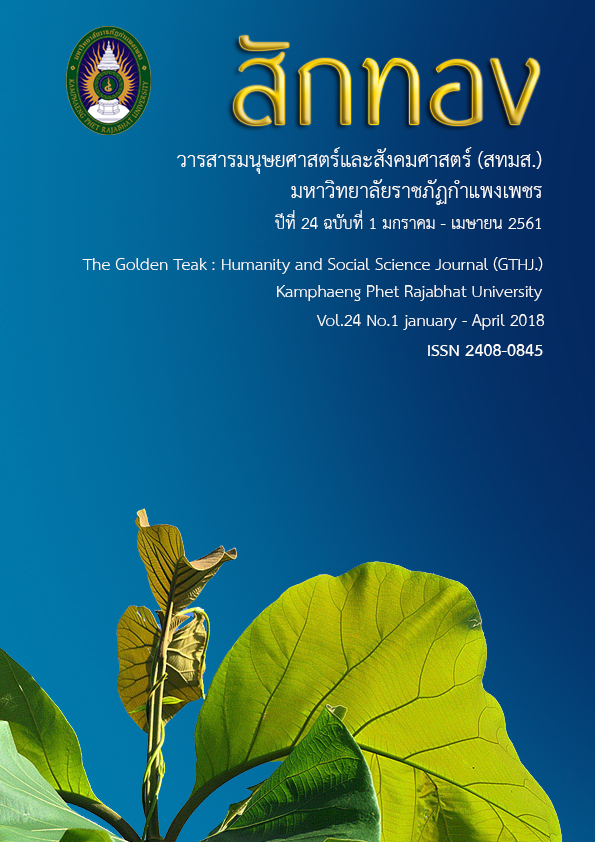A Development of a Blended Instruction Model to Enhance Creative Thinking for Lower Secondary Level Students
Main Article Content
Abstract
The Purposes of this research were 1. to develop a blended instruction model to enhance creative thinking for lower secondary level students, 2. to study the effects of using the blended instruction model to enhance creative thinking for lower secondary level students. The research processes were to research and develop. The samples used in this research were the students of Klonglanjindasak School, who were lower secondary level students from nine classrooms with a total of 233 students in the first semester of academic year 2016. An experimental group and a control group of 30 students each were purposively selected. The instruments used in the research were a focus group discussion recording form, quality assessment forms, creativity evaluation forms, management plans for teaching, and learning achievement tests. The statistics used were mean and standard deviation. The qualitative data were analyzed by using content analysis. The research results were found as follows: 1) The instruction model from the theory of Constructionism with basic concepts about blended learning and creative thinking has six components: (1) Principle. (2) Objective. (3) Content. (4) Process of teaching which has three phases: phase 1) pre-teaching; phase 2) the teaching process which has four stages namely exploration (Explore), trial (Experiment), learning from formalism (Learning by Doing), and do in order to make learning (Doing by Learning); phase 3) the measurement and evaluation. (5) measurement and evaluation, and (6) roles of the teacher and the learner. 2. The study found that the results of the model were as follows: 1) The achievement of students with some form of a blended instruction model to enhance creative thinking was higher than before at the .05 level of statistical significance, and 2) the students with some form of a blended instruction model to enhance creative thinking (experimental group), had higher creative thinking abilities than those with normal style of teaching (control group) significantly at the level of .05.
Article Details
บทความที่ได้รับการตีพิมพ์เป็นลิขสิทธิ์ของวารสาร สักทอง : วารสารมนุษยศาสตร์และสังคมศาสตร์ สถาบันวิจัยและพัฒนา มหาวิทยาลับราชภัฏกำแพงเพชร
ข้อคิดเห็นใดๆ ที่ปรากฎในวารสารเป็นวรรณกรรมของผู้เขียนโดยเฉพาะ ซึ่งมหาวิทยาลัยราชภัฏกำแพงเพชรและบรรณาธิการไม่จำเป็นต้องเห็นด้วย
References
Kanchanachaya, N. (2012). Development of a Blended Learning Model Based on Creative Problem Solving Principles Using Lateral Thinking to Enhance Creative Problem Solving Abilties for Instructional Media Production of Pre-Service Teachers. Journal of Education Studies. Chulalongkorn University.
Khammanee, T. (2008). Science of Teaching. Bangkok : Chulalongkorn University.
Khantapthai, T. (2011). A Development of a Blended Learning Model for Learning an Information Technology for Life Course of Undergraduate Students at Rajabhat University. Mahasarakham University.
Mingsiritham, K. (2009). Development of A Web-based Learning Model Integrating Cooperative Learning and Collaborative Learning to Enhance Self-Derected Learning of Pre-Service Teachers. Journal of Education Studies. Chulalongkorn University.
National Education Commission, Office. (2002). National Education Act 1999 and Amendments (No. 2). 2002. Bangkok: National Education Commission.
Netwong, T. (2010). Development of A Mainstreaming Model to Develop Online Learning Community and Learning Achievement in Information Technology for Undergraduate Students. Journal of Education Studies. Chulalongkorn University.
Office of the Education Council. (2014). Constructionism. Thailand Education Journal.
_______. (2010). National Education Improvement Plan (2009-2016). Bangkok : Prikwangraphic.
Palacheewa, P. (2007). Enhancing Metacognitive Skills Using Computer-Supported Collaborative Learning with Brainstorming and Argumentative Technique in Project-Based Learning Using Strategic Metacognition Questions For Upper Secondary School Students. Journal of Education Studies. Chulalongkorn University.
Phrompan, I. (2007). A Development of A Web-Based Instructional Model Based on Brain-Based Learning Process Indesign Course to Enhance Creative Thinking of Undergraduate Students. Journal of Education Studies. Chulalongkorn University.
Sinlarat, P., et al. (2007). Research Project Desirable Characteristics of Students in Knowledge Based Economy Societies. Bangkok : Faculty of Education Chulalongkorn University.
Tanunchaibutra, P. (2010). The Develoment of Visual Art Learning Management Model to Enhance Creativities. Journal of Education Studies. Chulalongkorn University.
Torrance, E.P. (1965). Rewerding Creative Behavior. Englewood Cliffs, New Jersey : Prentice-Hall.
Wannapiroon, P. (2008). Development of A Problem-Based Blended Learning Model to Develop Undergraduate Students’ Critical Thinking. Journal of Education Studies. Chulalongkorn University.
Yuangsoi, P. (2011). The Development of the Blended Instructional Model to Encourage Problem-Solving Skills in The Line of Ariyasacca Principle in Project-Based Assignment For Undergraduate Students. Thesis Ph.D. in Education Technology and Communication, Narasuan University.


